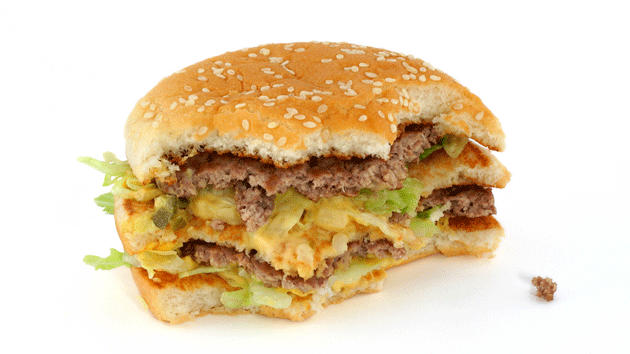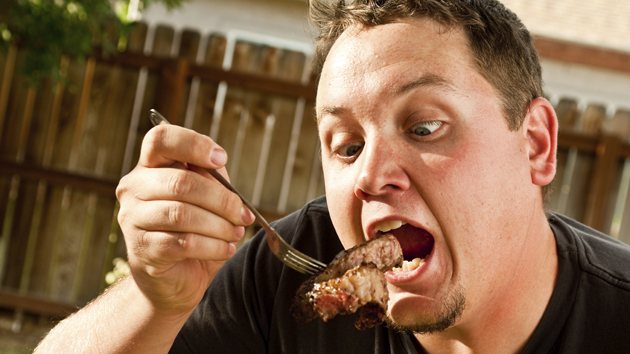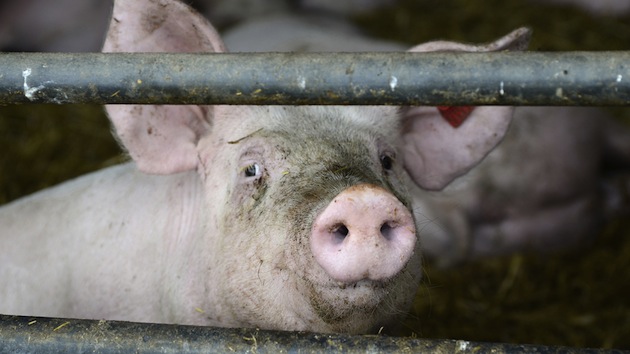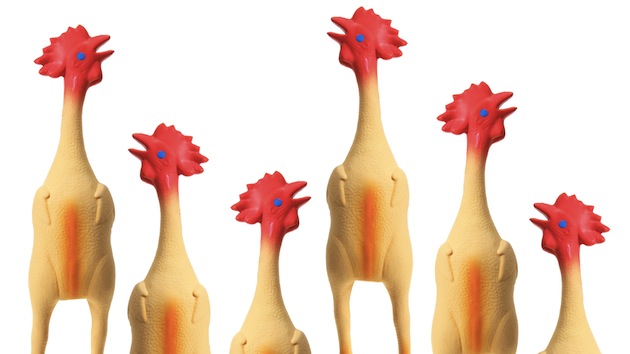
<p><a href="http://www.shutterstock.com/cat.mhtml?lang=en&language=en&ref_site=photo&search_source=search_form&version=llv1&anyorall=all&safesearch=1&use_local_boost=1&autocomplete_id=14338907579165160000&searchterm=half%20eaten%20burger&show_color_wheel=1&orient=&commercial_ok=&media_type=images&search_cat=&searchtermx=&photographer_name=&people_gender=&people_age=&people_ethnicity=&people_number=&color=&page=1&inline=2065763" target="_blank">worker</a>/Shutterstock</p>
The great bulk of American beef comes from cows that have been fattened in confined yards with thousands of of their peers, munching a diet of corn, soybeans, and chemical additives. Should the feedlot model, innovated in the United States in the middle of the 20th century, continue its global spread—or is it better to raise cows on pasture, eating grass?
The question is critical, because global demand for animal flesh is on the rise, driven by growing appetites for meat in developing countries, where per capita meat consumption stands at about a third of developed-world levels.
In a much-shared interview on the website of the Breakthrough Institute, Washington State University researcher Judith Capper informs us that the US status quo is the way forward. “If we switched to all grass-fed beef in the United States, it would require an additional 64.6 million cows, 131 million acres more land, and 135 million more tonnes of greenhouse gas emissions,” she said. “We’d have the same amount of beef, but with a huge environmental cost.”
I agree with Capper that it would be a disaster to empty the feedlots and put all of the hungry cows out to pasture—that is, at current levels of beef production, finding enough grass to feed every cow that now relies on copious supplies of corn would likely prove impossible.
But there’s a deeper question that Capper doesn’t look at: Is the feedlot system itself sustainable? That is, can we keep stuffing animals—not just cows but also chickens and pigs—into confinements and feeding them gargantuan amounts of corn and soybeans? And can other countries mimic that path, as China is currently?
The answer, plainly, is no, according to the eminent ecologist Vaclav Smil in a 2014 paper. Smil notes that global meat production has risen from less than 55 million tons in 1950 to more than 300 million tons in 2010—a nearly six-fold increase in 60 years. “But this has been a rather costly achievement because mass-scale meat production is one of the most environmentally burdensome activities,” he writes, and then proceeds to list off the problems: it requires a large-scale shift from diversified farmland and rainforests to “monocultures of animal feed,” which triggered massive soil erosion, carbon emissions, and coastal “dead zones” fed by fertilizer runoff. Also, concentrating animals tightly together produces “huge volumes of waste,” more than can be recycled into nearby farmland, creating noxious air and water pollution. Moreover, it’s “inherently inefficient” to feed edible grains to farm animals, when we could just eat the grain, Smil adds.
This ruinous system would have to be scaled up if present trends in global meat demand continue, Smil writes—reaching 412 million tons of meat in 2030, 500 million tons in 2050, and 577 million tons in 2080, according to projections from the UN’s Food and Agriculture Organization. Such a carnivorous future is “possible but it is neither rational nor sustainable”—it will ultimately destroy the ecosystems on which it relies.
Smil is no anti-meat crusader. He acknowledges that “human evolution has been closely linked in many fundamental ways to the killing of animals and eating their meat.” But the rise of the feedlot has provided much more meat than is necessary nutritionally—Americans consume on average about 209 pounds of meat per year, while a “wealth of evidence confirms” that a bit less than 100 pounds is “compatible with good health and high longevity.”
He calculates that such a level could be achieved globally, without the ecosystem destruction built into the status quo meat production model. Rather than gobble up stuff we could eat like corn and soybeans, farm animals should be fed solely crop residues and food waste. And rather than be crammed into concentrated feedlots, they should be kept on pasture in rotation with food crops. Managing meat production that way, he calculates, would generate more than 200 million tons of meat per year—about enough, he calculates, to provide the globe with sufficient meat for optimal health.
Of course, massive challenges stand between Smil’s vision and reality. For one, it would require people in industrialized countries like the United States to cut their meat consumption by half or more, even as consumption in Asia and Africa rises to roughly equal levels. Then, of course, there are the massive globe-spanning meat companies like US-owned Tyson, Brazil-owned JBS, and China’s Smithfield that have a huge stake in defending the status quo.
But ramping up the current system to provide the entire globe with US levels carnivory is hard to fathom, too. If it happens, “there is no realistic possibility of limiting the combustion of fossil fuels and moderating the rate of global climate change,” Smil writes. In other words, like it or not, it’s probably time to get used to eating less meat—pushed by the climate crisis, industrialized societies may have little choice but to ramp down meat production along lines suggested by Smil.
Meanwhile, US meat consumption, long among the very highest in the world, is waning, if slowly. The total annual slaughter peaked at 9.5 billion animals in 2009, and has been hovering around 9.1 billion in recent years. Interestingly, Paul Shapiro, vice president of farm-animal protection of the Humane Society of the United States, told me that the decrease reflects meat eaters’ cutting back, not any turn to abstention—the percentage of vegetarians and vegans among the population has “remained relatively stable” in recent years, he said. (See my colleague Gabrielle Canon’s list of the most common ways in which meat eaters justify their diet here.)
If we can continue this trend, the feedlot, which looks hyper-efficient at mass-producing meat only if you ignore a host of environmental liabilities, may yet prove to be a passing fad.













